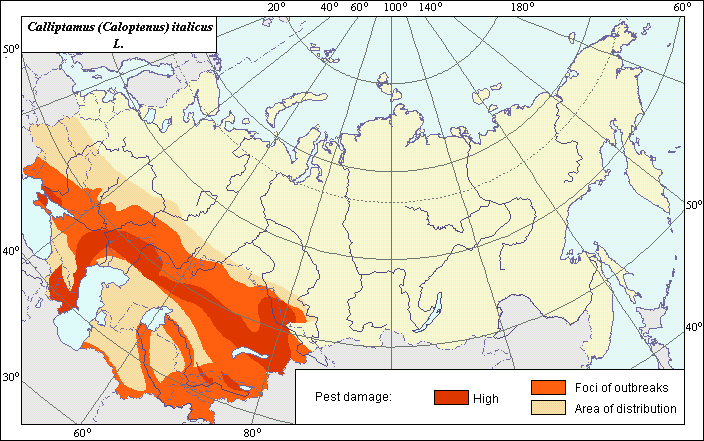Pests
The area and zones of mass reproduction of the Italian Locust (Calliptamus italicus L.)
 Object description Download GIS-layers
Object description Download GIS-layers
Authors:
Specialist-biologist I.Ya. Grichanov, GIS-specialist - M.I. Saulich.Date of creation:
6.08.2002.Scale:
1:20.000.000.Accuracy of map:
Map was created based on materials of maps of natural scale 1:12 000 000-1: 60 000000.Projection:
"Alber's Equal Area Conic for the USSR", 9, 1001, 7, 100, 0, 44, 68, 0, 0.Basic contents:
Vector map. Area of species distribution is shown by polygons. Zones of recorded mass outbreak are shown by polygons.Accuracy of classifier:
Within the area of reproduction of the Italian Locust, two zones have been defined:a zone where mass reproductions is relatively rare, and a zone where reporduction occurs regularly. Periodicity of the pest population mass outbreaks as well as economic significance was used to classify each zone.Method of map production:
Scientists were given maps with boundaries of Oblasts and arable lands. After reviewing historic literature, species distribution was hand drawn on maps. The general area was determined according to the following sources: Lachininskii et al. (2002), Sergeev et al. (2002). The borders of the zone of miduses of mass reproductions were determined according to Polyakov (1975). The zone of regular mass reproductions was determined according to Sergeev et al. (2002). If data were on the Oblast-level, distribution is on the Oblast level. In some cases, Oblast.s are further refined by boundaries of the Arable Land Map (Koroljeva et al., 2003). Hand drawn maps were scanned, georeferenced and vectorized.Reference citations:
Bei-Bienko G.Ya. 1932. A manual of locust survey. Leningrad: Upravlenie Sluzhby ucheta Gos. OBV Narkozema SSSR. 159 pp. (In Russian)Koroljeva IE, Vilchevskaya EV, Ruhovich DI. 2003. Digital Arable Land Map. Laboratory of Soil Information of the Dokuchaev Soil Institute, Moscow, Russia [Based on: Yanvareva LF. (ed.), Martynjuk KN., Kisileva NM. 1989. Map of Land Use, Faculty of Geography, Moscow State University, Moscow, Russia.].
Lachininskii A.V., Sergeev M.G., Chil.debaev M.K., Chernyakhovsky M.E., Lockwood J.A., Kambulin V.E., Gapparov F.A. 2002. Locusts of Kazakhstan, Central Asia and adjacent territories. Laramie: Association for Applied Acridology International, University of Wyoming. 387 pp. (In Russian)
Mishchenko L.L. 1952. Locusts (Catantopinae). Fauna of the USSR. Leningrad: AN SSSR. Orthopterous insects, V. 4(2): 610. (In Russian)
Polyakov I.Ya., ed. 1975. Distribution of main pests of agricultural crops in the USSR and efficiency of their control (Methodical recommendations). Leningrad: VASKHNIL, VIZR. 66 pp.
Sergeev M.G. 1986. Regularities in distribution of orthopterous insects of Northern Asia. Novosibirsk: Nauka. 238 pp. (In Russian)
Sergeev M.G., Lachininskii A.V., Lockwood J.A., Vanjkova I.A., Denisova O.I. 2002. Locusts and Grasshoppers. Distribution, Ecology, Population Management. Novosibirsk: Novosibirsk State University. 103 pp. (In Russian)
Uvarov B.P. 1977. Grasshoppers and Locusts. A Handbook of General Acridology. V. 2. London: Center for Overseas Pest Research, Cambridge University Press. 613 pp.
Right and copyright:
All rights reserved. Copyright 2003 © I.Ya. Grichanov & M.I. Saulich (vector map, description)Photo © V.V.Neymorovets (VIZR)

